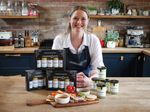By Marjorie Grice DipION mBANT mCNHC

Healthy Skin from the inside out
It has been said that your skin is a mirror of your health, but healthy skin from the inside out means taking a holistic approach. Let’s face it, pun intended what you nourish your body with is bound to affect your skin and this can improve skin health as your nutrition and your skin are uniquely interlinked, but it can be a rocky relationship! Firstly, we need to understand how our health affects the skin so I will explain the key underlying factors affecting your skin. Secondly, we need to identify our risk factors, and lastly you can identify the root causes of your personal skin concerns and look at nutritional and lifestyle changes to address them.

Quick fix solutions
These include harsh products, or rich reams, heavy makeup, even medication and food supplements that often mask the real issues or even exacerbate the problem. They often promise the ‘answer’ costing us time and money and then leave you frustrated. They may make superficial changes that work for a while but cannot resolve the underlying issues at play during hormonal breakouts, ageing, pigmentation, photo damage, dryness or dehydration. Healthy skin from the inside out is a better approach and many root causes stem from immune inflammation.
Healthy skin function
Skin has many functions including, protection from injury, microbes, UV irradiation, and environmental toxins and temperature regulation and water retention which it can only perform effectively when perfectly balanced internally (Matejuk, 2018). Effective ‘turnover’ of the skin cells is the essential process of skin regeneration, the skin you see originates from stem cells in the bottom layer of the epidermis and they change ‘differentiate’ while moving up to the skin surface, forming the many layers that make up the epidermis. The cells differentiate into three cell types, basal cells, spinous cells, and granule cells before finally becoming the corneocytes that make up the outermost layer of the epidermis called the stratum corneum. This process of differentiation is also known as keratinization and is controlled by genetic factors (Yousef & Sharma, 2018). The structured process results in about 15 layers of densely keratinized layered corneocytes. These are like bricks held together with mortar! The many lipid bilayers; ceramides, cholesterol, fatty acids, and cholesterol esters make up the mortar that holds the bricks together.
When epidermal turnover functions properly this structure makes an effective skin barrier so it can limit evaporation, preserve skin moisture, and protect from foreign organisms and substances (Salem et al., 2018). Because of the protective role the skin houses many specialised immune cells both in the epidermis and lower dermis as the skin is key as the bodies first defence system, it plays a major immune regulatory role (Matejuk, 2018). So healthy skin from the inside out means protecting your immunity.
Immunity and healthy skin
So how is this intricate process and balance disrupted? The main internal factor affecting the skin has to do with immunity. This skin- immune relationship works well when your immune system is healthy keeping your body protected from infections and viruses. When bacteria, toxins, physical or psychological trauma or stress affect the body, the immune system gears up with a short burst of inflammation to remove the threat called short term or acute inflammation. Without this inflammatory response a small cut could become life threatening and we would not be able to build muscle in the gym! So, inflammation can be a good thing as it helps to heal the breaches in the skin barrier, isolate harmful antigens and attracts immune cells to get rid of the intruders. Some cells may produce antibodies preventing reinfection.(Matejuk, 2018) see Immunity Blog
The secret attacker of healthy skin
The problem occurs when inflammation is chronic or long term, a phenomenon termed “inflammaging”. This can also affect the entire body triggering an immune cascade that lasts indefinitely. It has also been called silent inflammation, as our bodies adapt and cope while it lingers undetected. This lasting immunological attack on organs results in skin damage and chronic inflammatory diseases (Fleit, 2014).
We have all been affected by Covid-19. Many lost their lives, and this seems to be partly due to comorbidities. This may be determined by the immune system’s ability to control the level of immune response that causes ‘inflammation’ in the body. Worldwide, three out of five deaths are due to chronic inflammatory diseases such as stroke, respiratory diseases, heart disorders, cancer, obesity, and diabetes. (Chronic Inflammation – StatPearls – NCBI Bookshelf, 2020) Astoundingly statistics say one in ten people over 40 have type 2 diabetes and around a quarter of the UK population suffers from multiple morbidities (2 or more chronic conditions) (Number of People with Diabetes Reaches 4.7 Million | Diabetes UK, 2019). A studies also link metabolic syndrome, (comorbid conditions like heart disease, diabetes, obesity) to various skin conditions such as psoriasis, litchen planus and even skin cancers (Padhi & Garima, 2013).
‘Inflammaging’
Our skin is not exempt from the effects of inflammation and how we deal with this can determine how well our skin ages too. Skin is susceptible to acute as well as chronic inflammation, as conditions like eczema result in compromised skin barrier and immunity. External factors can impact the skin causing free radical production and inflammation, especially the sun with both UVA and UVB radiation. Also exposure to chemicals, pollutants, smoking, food intolerance and even skincare products can all cause an inflammatory response and skin problems. (Lobo et al., 2010). A poor diet, processed foods low in nutrients can also accelerate ageing and genetics has a role to play but do not have to determine our outcomes (Bin & Leung, 2016).
We are all familiar with aging characteristics such as thin and dry skin, fine wrinkles, decreased elasticity and abnormal pigmentation. There is a decreased production and renewal of basal keratinocytes and reduced epidermal cells leading to the epidermal thinning and damage to the pigment producing cells becomes visible as the more cells are damaged and become more visible over time (Wang & Dreesen, 2018).
The power of healing foods
There is plenty of scientific evidence to support the healing power of healthy foods, thus helping healthy skin from the inside out. Chronic inflammation results in inflamed organs, blood vessels, brain tissue and joints and skin! Some foods stimulate this inflammatory reaction others turn the inflammation off and help repair damage. Managing stress as well as eating a healthy varied diet high in vegetables and avoiding processed foods and refined fats oils will decrease our risk of chronic inflammation.(Cao et al., 2020). An anti-inflammatory diet, often referred to as the Mediterranean Diet, will subdue inflammation helping us to improve our skin from the inside and out (Romagnolo & Selmin, 2017).
Anti-inflammatory Diet – Healthy skin from the inside out
Vegetables & Fruits
Eat a rainbow and include plenty cruciferous vegetables (broccoli, cauliflower, cabbage kale). Great for the gut and liver function.
All berries are super foods! As high in polyphenols.
Squashes & sweet potatoes are rich in vitamin A, great for the skin
Whole and cracked grains, occasional pasta, cook al dente)
Soy in the forms of edamame, tofu, and tempeh
Beans, lentils, quinoa and barley will help you feel full!
Healthy Fats
Omega-3 (from fish, flax or chia seeds)
Raw unroasted nuts & seeds & nut butters
Extra virgin olive oil or other unrefined oils
Avocados
Proteins (limit animal products)
Fish rich in omega-3 fats, including wild Alaskan salmon, herring, sardines mackerel.
Grass fed animals & dairy
Legumes (adzuki beans, black beans, chickpeas, black-eyed peas & lentils)
Almonds and Walnuts (raw is better than roasted)
Asian mushrooms (maitake, shitake, wild)
High quality dairy & eggs & cheese
Spices, Drinks & Chocolate!
Season food with turmeric, curry powder, ginger, garlic, chili peppers, cinnamon, and other herbs & spices.
Tea is a great alternative for coffee
Limited alcohol intake (1-2 servings a day) *Red wine is best choice.
Dark chocolate (minimum cocoa content of 70%)
Consider organic and eat foods in-season. Add vinegar to dishes as it lowers glycemic load. (how quickly food raises blood glucose levels).
A Unique Duo Skin Health and Nutrition
Personalised nutrition is not a one size fits all approach but gets to the root the cause of health and skin problems. As a registered nutritionist (mBANT) I can help you on this journey with bespoke nutrition and lifestyle recommendations to protect and balance your health and your skin. As a qualified skin therapist I can also support this with advanced skin treatments. Truly healthy skin from within!
References
Bin, L., & Leung, D. Y. M. (2016). Genetic and epigenetic studies of atopic dermatitis. In Allergy, Asthma and Clinical Immunology (Vol. 12, Issue 1). BioMed Central Ltd. https://doi.org/10.1186/s13223-016-0158-5
Cao, C., Xiao, Z., Wu, Y., & Ge, C. (2020). Diet and skin aging—from the perspective of food nutrition. In Nutrients (Vol. 12, Issue 3). MDPI AG. https://doi.org/10.3390/nu12030870
Chronic Inflammation – StatPearls – NCBI Bookshelf. (n.d.). Retrieved July 23, 2020, from https://www.ncbi.nlm.nih.gov/books/NBK493173/
Fleit, H. B. (2014). Chronic Inflammation. In Pathobiology of Human Disease: A Dynamic Encyclopedia of Disease Mechanisms (pp. 300–314). Elsevier Inc. https://doi.org/10.1016/B978-0-12-386456-7.01808-6
Lobo, V., Patil, A., Phatak, A., & Chandra, N. (2010). Free radicals, antioxidants and functional foods: Impact on human health. In Pharmacognosy Reviews (Vol. 4, Issue 8, pp. 118–126). Wolters Kluwer — Medknow Publications. https://doi.org/10.4103/0973-7847.70902
Matejuk, A. (2018). Skin Immunity. In Archivum Immunologiae et Therapiae Experimentalis (Vol. 66, Issue 1, pp. 45–54). Birkhauser Verlag AG. https://doi.org/10.1007/s00005-017-0477-3
Number of people with diabetes reaches 4.7 million | Diabetes UK. (n.d.). Retrieved July 23, 2020, from https://www.diabetes.org.uk/about_us/news/new-stats-people-living-with-diabetes
Padhi, T., & Garima. (2013). Metabolic syndrome and skin: Psoriasis and beyond. Indian Journal of Dermatology, 58(4), 299–305. https://doi.org/10.4103/0019-5154.113950
Romagnolo, D. F., & Selmin, O. I. (2017). Mediterranean Diet and Prevention of Chronic Diseases. Nutrition Today, 52(5), 208–222. https://doi.org/10.1097/NT.0000000000000228
Salem, I., Ramser, A., Isham, N., & Ghannoum, M. A. (2018). The gut microbiome as a major regulator of the gut-skin axis. In Frontiers in Microbiology (Vol. 9, Issue JUL). Frontiers Media S.A. https://doi.org/10.3389/fmicb.2018.01459
Wang, A. S., & Dreesen, O. (2018). Biomarkers of cellular senescence and skin aging. In Frontiers in Genetics (Vol. 9, Issue AUG, p. 247). Frontiers Media S.A. https://doi.org/10.3389/fgene.2018.00247
Yousef, H., & Sharma, S. (2018). Anatomy, Skin (Integument), Epidermis. In StatPearls. StatPearls Publishing. http://www.ncbi.nlm.nih.gov/pubmed/2926215






